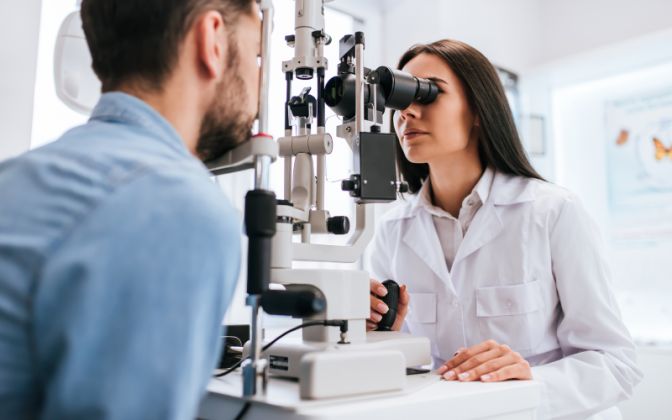Buy One, Get One 50% OFF Eyeglasses
* Restrictions apply. Ask a Team Member for details.
What is Astigmatism?
At first glance, the human eye appears perfectly round. But for many people with astigmatism, that's not necessarily the case. Astigmatism is a common and treatable eye condition that affects about one in three Americans to some degree. It's caused by having a misshapen cornea or lens. The cornea is the transparent dome on the surface of the eye, covering your iris and pupil. The lens is behind the iris and pupil, helping to focus light rays.
Your cornea controls the way light enters your eye. When light hits a smooth, round cornea, it's able to be sharply focused and result in clear sight. If your cornea isn't perfectly round, however, light cannot hit the cornea properly. In a person with astigmatism, the cornea is shaped like a football or an egg, rather than rounded. This means that when light hits their cornea, rays don't refract, or bend, properly. Known as a "refractive error," astigmatism results in distorted vision, rather than clear. People can also experience nearsightedness or farsightedness, too. Read on to learn more about this eye condition, its symptoms and how The EyeDoctors Optometrists can help correct your vision.
Risk factors
Experts don't know exactly what causes cornea shapes to vary. However, astigmatism is primarily genetic and usually present from birth. A kid's eye exam at The EyeDoctors Optometrists can help determine if young children are experiencing this eye condition or any others. Astigmatism can develop later in life due to risk factors like:
Eye disease
Eye injury
Eye surgery (like cataract surgery)
Signs and symptoms
Cornea and lenticular astigmatism are the two types of astigmatism. Corneal is due to a misshapen cornea, and lenticular is from a distorted lens. Both types have very similar symptoms. It's also typical to experience symptoms that can be common in other eye problems. Blurry and distorted vision is common in people experiencing nearsightedness and farsightedness. If you're not sure your blurry vision is due to astigmatism, other potential symptoms may include:
The need to squint to bring things into clearer focus
Headaches
Eyestrain or discomfort
Difficulty seeing at night
The best course of action if you suspect astigmatism — or any time you experience vision problems — is to schedule an exam at The EyeDoctors Optometrists. A simple and painless comprehensive eye exam is the only way to know for sure whether you have astigmatism. The exam will measure the way your eyes focus light, the curvature of your cornea and how well you can read a distance chart to determine if you have astigmatism.
How to correct or treat astigmatism
Fortunately, many treatment options for astigmatism exist. The skilled optometrists at The EyeDoctors Optometrists specialize in a variety of eye conditions, such as astigmatism. Our doctors work with you to determine the best path of treatment and find a solution for your vision problems. Learn more below about some treatment options.

Schedule an eye exam at The EyeDoctors Optometrists
Astigmatism is a common vision condition that can lead to blurry sight. The good news is that there are many easy and pain-free treatments that help bring your world into sharper focus. If you think you're experiencing an eye condition, schedule an eye exam at The EyeDoctors Optometrists to get your vision back on track.
Schedule a In-Office Remote Eye Exams Visit with The EyeDoctors
A virtual visit with your local Kansas eye doctor is more convenient than making a trip to your favorite The EyeDoctors location. All you need is a smartphone or laptop with access to the internet.